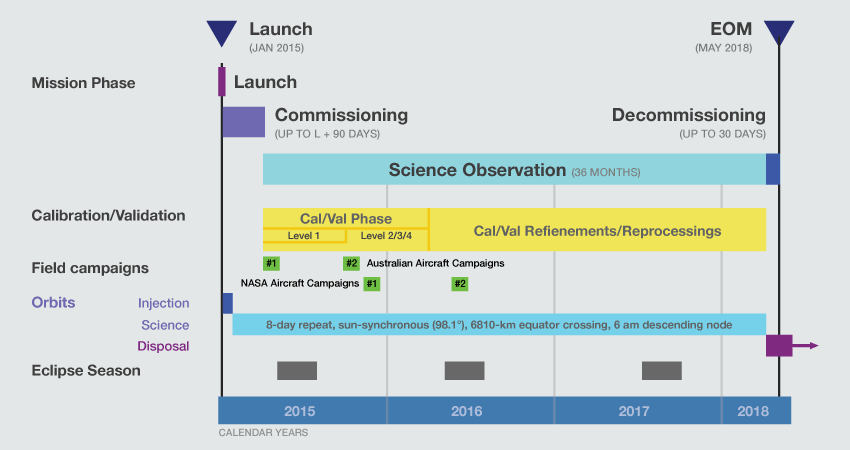
This chart provides an overview of mission events and operations during SMAP primary mission.
Commissioning
Immediately after launch in January 2015, SMAP entered a busy 90-day period called “commissioning.” Spacecraft functions were carefully checked out to insure they were healthy. Mission controllers on the ground established a regular cadence of observatory communication and control activities. The large instrument reflector boom was deployed according to plan, and the reflector was then unfurled. Final adjustments to SMAP’s orbit was made. The instrument was carefully spun up to its operational 14.6 rpm spin rate. The instrument was then fully powered on and checked to insure it is healthy. The science data processing system on the ground established the routine on-going processing of instrument data. During commissioning, the ‘first light’ science data images were released to the public to confirm that the observatory was operating and ready for its next phase of activity.
Routine Science Operation
The SMAP science operation started in April 2015. During and after the first year of intensive calibration/validation (Cal/Val), the SMAP observatory and ground operation systems operated in a repeating cycle of activities to communicate and command the spacecraft, and receive and process the data on the ground. SMAP uses a significant amount of automation in this process to reduce operating cost. Trained operators manage this process and monitor the health of the observatory and ground system and perform routine maintenance. When problems arise with the observatory or ground systems, they are ready to quickly respond and return the systems back to operation. The prime mission of SMAP was completed in summer 2018 with three years of science data for a wide range of research. Since then, SMAP has been approved to operate in extended phase through 2023. Future extensions will be reviewed every three years.
After the failure of SMAP L-band radar, European Union’s Copernicus Sentinel-1 synthetic aperture radar data with a full global land coverage every 12 days starting mid-2017 were used as a surrogate. The SMAP-Sentinel-1 combined data have been used to produce soil moisture products at a spatial resolution of 3 km since June 2018.
Calibration and Validation (Cal/Val)
Like any complex scientific instrument, the SMAP observatory’s data must be calibrated and validated so that the processed soil moisture and freeze-thaw data are accurate. For SMAP, this is immensely complicated because the data must be checked over the very diverse soil types, land cover, topography, weather and other atmospheric conditions that occur over the Earth’s varied continents and that can also change over the seasons. This is a step-wise process that starts with calibrating the lowest-level (“Level 1”) raw data from the instrument (radar “backscatter” and radiometer “brightness temperature”) against known ‘standards’, including other calibrated aircraft & spacecraft instruments and different well-characterized locations around the globe, including the amazon forest canopy and the oceans. Uncalibrated (‘beta’) Level 1 data were released 3 months after commissioning was completed, and fully calibrated Level 1 data were released 6 months after commissioning.
With the Level 1 data calibrated, the next step is to validate the ground processing that produces the higher level soil moisture and freeze thaw data from the lower level data. During this step, soil moisture data is compared with numerous sites around the globe that have been outfitted with soil moisture probes – these sites have been set up for other scientific research, but SMAP is able to use them to compare and adjust soil moisture measurements over the very diverse conditions over which the measurements must be made. Validation is also augmented by comparing SMAP’s data with aircraft instrument measurements made at the same time and locations. Unvalidated (‘beta’) soil moisture data (Levels 2, 3, and 4) were released 6 months after commissioning was completed, and fully validated data will be released 12 months after commissioning. The fully validated freeze-thaw data was released 15 months after commissioning. The special SMAP-Sentinel-1 product was released in June 2018.
The intensive Cal/Val campaign that precedes the first release of calibrated and validated data ensure that it meets accuracy requirements established by NASA for the mission. However, Cal/Val will be ongoing throughout the mission so that the data quality will continue to be gradually refined and improved over time. After this first year of operation and occasionally thereafter, all of the acquired data have been reprocessed annually to incorporate improvements and refinements in the processing and ensure the entire data is consistently processed.
Disposal
At the end of the mission’s useful life, the observatory will undergo a disposal process that will safely remove it from Earth’s orbit in a relatively short amount of time (less than 25 years), so that it does not remain in orbit as a source of debris to threaten other operating missions.




